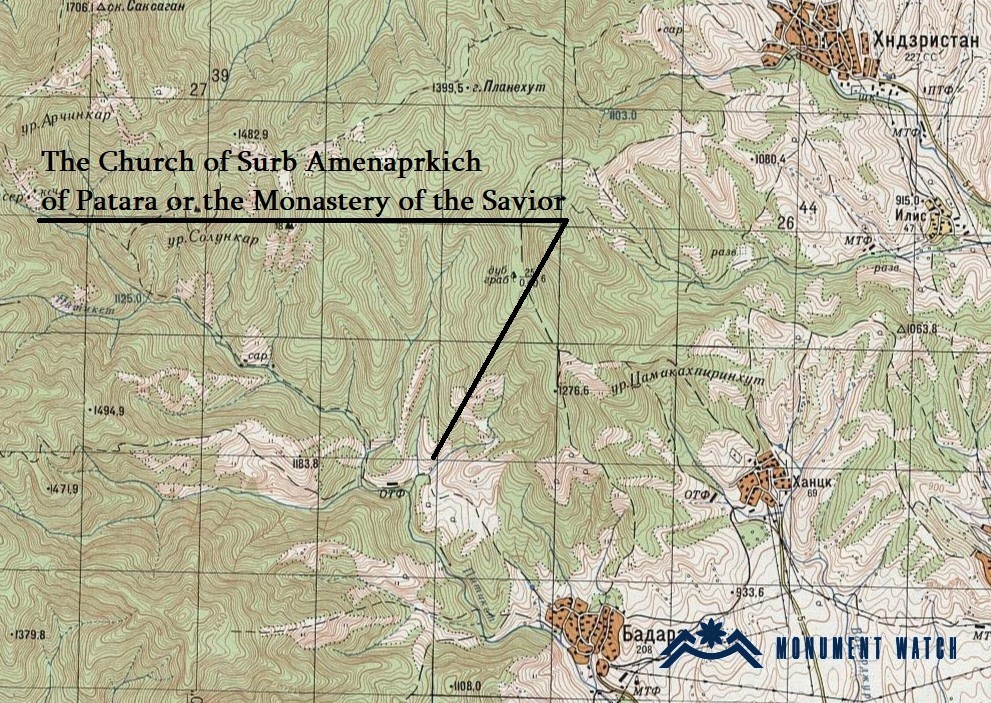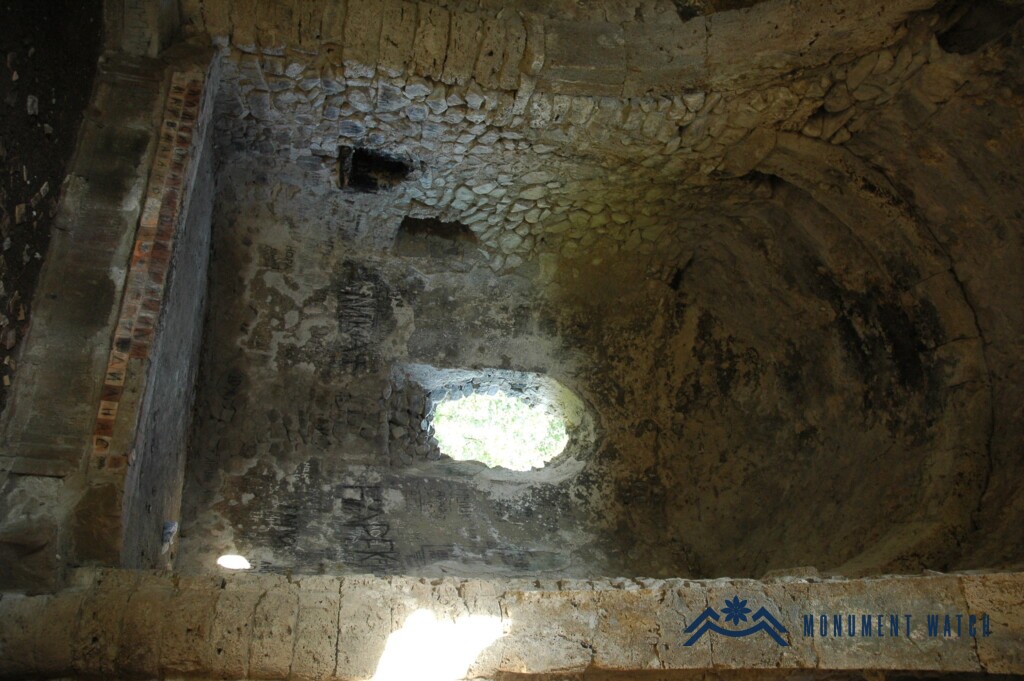The Church of Surb Amenaprkich of Patara or the Monastery of the Savior
Location
The monument is located approximately 2.5 kilometers northwest of the village of Patara, within the Askeran region of the Republic of Artsakh. In addition to the church (Figs. 1 and 2), the site also includes the remains of an ancient settlement and a cemetery (Barkhutareants 1895, 158; Karapetyan 1984, 83).
Historical overview
Historical information about the church and the settlement is lacking. Some information is available from the construction inscription, which has suffered significant damage. This inscription is engraved on six slabs forming the platform of the main altar in proportional and large letters (Fig. 3). The inscription was published by Makar Barkhutaryants (Barkhutareants 1895, 157). "In the name of... we have painted the mansion of our church...
The elders of Ukhan. They gave me during the eight days of the Resurrection (Easter) the gifts of bread and salt. And from Easter onwards, on the new Sunday, they will perform the liturgy for us. The mansion of Vachar, and the houses of Hurrahoa, belong to our church" (CAE 5, 142). Based on the inscription, it can be inferred that the Church of Surb Amenaprkich was constructed during the 12th to 13th centuries (Karapetyan 1984, 83-84). The term "Vachar" appears in the inscription, encountered several times in other medieval inscriptions of Artsakh. Two settlements named Vachar existed in Artsakh: Karvachar and Harva Vachar (Petrosyan 2019, 11-12), both commercial centers. It is not excluded that our inscription refers to Harva Vachar or another trading settlement near the monastery.
Another significant term mentioned in the inscription is "darapas". It is known that in medieval Armenia, princely palaces were called darabas or darapas. The ruins of the Khachen princely palace also bore the name Darpasner (Ghulyan 1984, 51-53). According to Shahen Mkrtchyan, these areas served as administrative and spiritual centers for the Khachen principality in the second half of the 13th century (Mkrtchyan 1985, 159-160).
Architectural-compositional examination
The architectural layout of the church adheres to the single-nave vaulted hall design with adjoining vaults, a construction style prevalent from the 11th to the 13th centuries (Fig. 4). The structure is built from rough-hewn stones of varying sizes. At the same time, the pillars and cornerstones are crafted from polished stone. Above the chancel on the western facade, small rectangular openings run along the entire length of the wall, suggesting that an additional structure may have once been attached to this site ( Fig. 5). The church features two entrances: one on the western side (Fig. 6) and another on the southern side (Fig. 7). The construction material consists of locally sourced pumice. The sacristies are situated on both sides of the tabernacle (Fig. 8), with a baptismal font positioned along the northern wall. On the eastern facade, two external triangular niches extend the full height of the building (Fig. 9; Karapetyan 1984, 83-84).
Near the southern entrance stands a khachkar, on the lower part of which an armed horseman is depicted (Fig. 10). On some stones of the church, there are engraved donation crosses (Fig. 11).
The condition before and after the war
The roof of the church is overgrown with grass, and a substantial breach is visible on the eastern facade, centrally located within the structure. The site is currently under the control of Azerbaijani armed forces.
Bibliography
- Barkhutareants 1895 - Barkhutareants M. , Artsakh, Baku.
- CAE 5 - Corpus of Armenian lithography, school 5, Artsakh, compiled by S. Barkhudaryan, Yerevan, 1982.
- Karapetyan 1984 - Karapetyan S., Historical-architectural monuments of Ptretsik river valley according to newly discovered inscriptions, Journal of Social Sciences, Yerevan, N 8, p. 51-57.
- Ghulyan 1984 - Ghulyan A., The Melik Mansion of Khachen, Journal of Social Sciences, No. 3, pp. 51-57.
- Mkrtchyan 1985 - Mkrtchyan Sh., Historical and architectural monuments of Nagorno Karabakh, Yerevan.
- Petrosyan 2019 - Petrosyan H., The main results of the archeological research of the Saint Stepanos Monastery in Vat and newly discovered inscriptions, Sedrak Barkhudaryan 120. Collection of scientific articles, Yerevan, Science, pp. 11-30.
The Church of Surb Amenaprkich of Patara or the Monastery of the Savior
Artsakh











